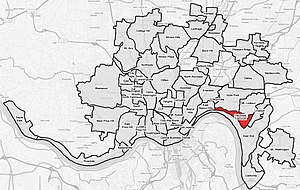Columbia-Tusculum, Cincinnati
Columbia-Tusculum | |
|---|---|
 Columbia-Tusculum is a neighborhood of Cincinnati, Ohio | |
| Website | Columbia-Tusculum Neighborhood Site |
Columbia-Tusculum is the oldest neighborhood in Cincinnati, Ohio, and is located on the East Side of the city. The population was 1,304 at the 2010 census.[1]
History[]
Columbia was founded in 1788 on the Little Miami River and predates Losantiville (which became Cincinnati) by a month.[2] The first Protestant church (Baptist) in the Northwest Territory was erected in Columbia.[3] The Cincinnati area's first school opened here in 1790. Many of the early settlers are buried in the former Columbia Baptist Cemetery, founded in 1790. The cemetery is now known as the Pioneer Memorial Cemetery.
In 1791, Columbia became part of Columbia Township. From the early 1840s, it was included in Spencer Township,[4][5] until Cincinnati annexed it in 1871.[6] Tusculum was annexed in 1875.[7]
The neighborhood is noted for its Victorian era homes decorated in the painted ladies multi-color style.[8] Designated historic structures in the neighborhood include the Bates Building, Kellogg House, LuNeack House, Norwell Residence, Spencer Township Hall, and the Stephen Decker Rowhouse.
It is also home to popular restaurants such as Allyn's Cafe and The Precinct, an upscale restaurant occupying the restored Police Station No. 6.[8]
Further reading[]
- Ford, Henry A.; Ford, Kate B., eds. (1881). "Spencer". History of Hamilton County Ohio, with Illustrations and Biographical Sketches. L. A. Williams & Co.
- Nelson, S. B.; Runk, J. M., eds. (1894). History of Cincinnati and Hamilton County, Ohio. Cincinnati: S. B. Nelson & Company – via Google Books.
References[]
- ^ "Columbia Tusculum Statistical neighborhood approximation". City of Cincinnati. p. 2. Archived from the original on 11 February 2017. Retrieved 27 January 2018.
- ^ Edwards, Jennifer (2003-12-29). "Columbia Tusculum redo planned". Cincinnati Enquirer. Cincinnati.com. Retrieved 14 May 2021.
- ^ Clarke, S. J. (1912). Cincinnati, the Queen City, 1788-1912, Volume 2. The S. J. Clarke Publishing Company. p. 530. Archived from the original on 2016-05-05. Retrieved 2013-05-20.
- ^ Ford & Ford 1881, p. 347.
- ^ Nelson & Runk 1894, p. 387.
- ^ Goss, Charles Frederic (1912). Cincinnati, the Queen City, 1788–1912. 2. Cincinnati: S. J. Clarke Publishing Company. p. 528 – via Google Books.
- ^ Hale, Harry L. (February 5, 1961). "Tusculum Once Known For Wealth Of Residents". The Cincinnati Enquirer. p. 7D – via Newspapers.com.
- ^ Jump up to: a b Agran, Hannah (October 2002). "Restoration Heaven: Comumbia-Tusculum is a Hot Spot for Painted Ladies". Cincinnati Magazine. p. 54. Archived from the original on 2021-05-14. Retrieved 2013-05-08.
External links[]
- Neighborhoods in Cincinnati
- Historic districts in Ohio
- Populated places established in 1788
- 1788 establishments in the Northwest Territory
- Hamilton County, Ohio geography stubs


